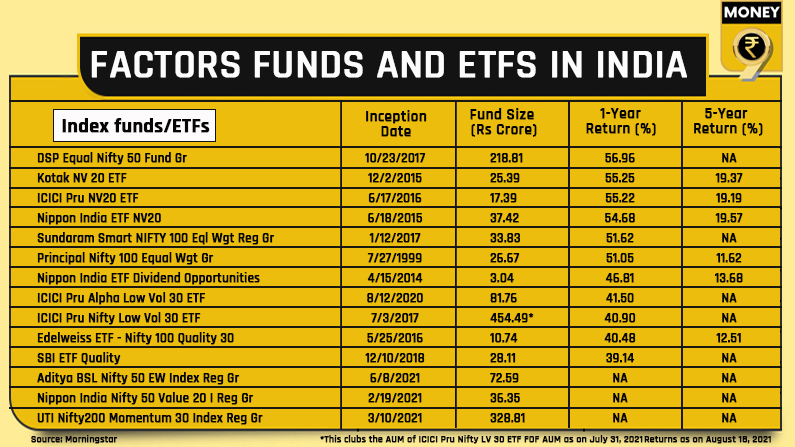Factor funds, ETFs give returns of up to 57% in a year; should you invest?
According to Anish Teli, Managing Partner & Principal Officer at QED Capital Advisors, factor investing helps in keeping emotions at bay.

The active versus passive debate has no end. How about making a balance? The investment world has no dearth of choices. If you don’t want fund manager’s active role in stock selection (as it is in passive funds) and still want alpha over a passive fund, then you may go for factor investing. Factor mutual funds and ETFs have rallied anywhere between 39% and 57% over the last one year. DSP Equal Nifty 50 Fund Gr, Kotak NV 20 ETF, ICICI Pru NV20 ETF, Nippon India ETF NV20 and Sundaram Smart NIFTY 100 Eql Wgt Reg Gr are among the top performers, rising 57%, 55.25%, 55.22%, 54.68% and 51.62%, respectively.
Three factor funds — Aditya BSL Nifty50 EW Index Reg Gr, Nippon India Nifty 50 Value 20 I Reg Gr, UTI Nifty200 Momentum 30 Index Reg Gr — have been launched in 2021 so far.
What is factor investing?
Giving an analogy of a marathon, Prashant Joshi, co-founder, Fintrust Advisors, portrays marathon runners as stocks. For the best outcome in competitive marathons, marathon runners can be divided as to how they perform in specific environment conditions such as winters, summers or rainy seasons.
“Now if a marathon is to be happening in an uphill in Pune in the rainy season, the runners can be easily shortlisted. No bias involved. Classification for peak performance is already there,” said Joshi.
This is what factor investing is – dividing stocks in terms of different parameters – called factors – for peak performance in the stock market. These factors could be quality, value and low beta. In single factor, only quality stocks will be chosen and multi-factor approach will club more than a single factor. For example, ICICI Pru Nifty Low Vol 30 ETF is a single factor fund while ICICI Pru Alpha Low Vol 30 ETF is a multi-factor fund as it involves two factors — alpha and low volatility.

“Single factors are cyclicals. They react faster to market moves, hence alpha generates in no time in the rising market scenario. Multi-factor funds give above average performance in the market upturn and downturn. They do well in the flat market. Besides, multi factor strategies outperform single factor strategies in the long-term,” explained Joshi.
According to a study conducted by Fintrust Advisors LLP, Nifty Alpha 50 index consistently performed well across various upcycles, followed by Nifty 200 momentum 30. “During down cycles, from mid to long tenure, Nifty low volatility 50 index took centre stage and performed well, followed by Nifty 200 quality 30. In the sideways (flat) market, Nifty 200 quality 30 index did well along with all the multi factor-based indices. All the multi-factor indices have lower volatility and have a better return profile in the long term in comparison to the broader market indices,” the study says.
Should you invest?
According to Anish Teli, Managing Partner & Principal Officer at QED Capital Advisors, factor investing helps in keeping emotions at bay.
“Retail investors tend to sell winners and hold on to losers. Factor investing follows a rule-based approach, which is much more efficient,” he said.
He further cautions that factor investing doesn’t work all the time.
“It works over a period of time. That being said, consider factor investment in your satellite portfolio. Don’t make it part of your core portfolio,” Teli said.
As you create a portfolio of it, focus on correlations of different strategies.
“Choose negatively co-related strategies. For example, choose factors funds having value and momentum strategies, which are negatively correlated so that if the value doesn’t perform, momentum can balance the portfolio returns,” Teli added.

